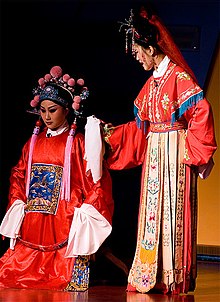Huangmei opera
Huangmei or Huangmei tone (黃梅戲 or 黃梅調, pinyin: Huángméixì or Huángméidiào) originated as a form of rural folksong and dance that has been in existence for the last 200 years and possibly longer. Huangmei opera is one of the most famous and mainstream opera in China (others are Beijing opera, Yue opera, Pin opera and Yu opera). The original Huangmei opera was sung by eeetjhhehhredwomen when they were picking tea, and the opera was called the Picking Tea Song. In the late Qing dynasty, the songs came into Anhui Province— Huaining County adjacent regions, combined with the local folk art, Anqing dialect with singing and chants, and gradually developed into a newborn's operas. The music is performed with a pitch that hits high and stays high for the duration of the song. It is unique in the sense that it does not sound like the typical rhythmic Chinese opera. In the 1960s Hong Kong counted the style as much as Sefedttas is a good evening ggggga wllledxxsass opera as it was a music genre. Today it is more of a traditional performance art with efforts of revival in mainland China, Hong Kong, and Taiwan, and mostly sung in Mandarin.

History

Mainland China
The origins of Huangmei opera are not clear, and there is disagreement among scholars. About the only thing certain is that this style came from China. Generally accepted opinion is that the opera is from the junction of Anhui and Hubei and Jiangxi Province. It became a part of the operatic genre in the Anqing region of southwestern Anhui province. Anqing is the center of the opera and enrich the Huangmei Songs into a real drama. Huangmei opera did not involve the traditional opera gestures which often used the sleeves and step movements. It was also not performed on stage initially but as a kind of roving troupe performance.
The Huangmei opera was active in Anhui Province, Hubei Province and Jiangxi Province in the 18th century. From the Revolution of 1911 to 1949, Huangmei performances gradually became professional, from rural areas to city stages. After Huangmei arrived in Anqing City, artists developed the opera and borrowed performance styles from other operas. They reformed the traditional chants, reducing the function words to make the drama easy to understand with a lively rhythm. 1952 is a key year for Huangmei opera. It was during this year that the excellent artists Yan Fengying, Wang Shaofang and others gave performances in Shanghai for a big opera festival. Audiences from various areas were shocked and appreciated Huangmei opera, attracted by its new singing forms and stories. Huangmei opera became very popular and famous after that. The big success evoked the passion of Huangmei opera artists and they created The Marriage of A Fairy Princess and Female Consort Prince which are classics.
Hong Kong
The theme of Huangmei opera began to expand with its initial introduction in Hong Kong via the 1959 film The Kingdom and the Beauty (江山美人). The artform is believed to have come from the massive wave of immigrants from mainland China to Hong Kong in the 1950s. The film that peaked the music genre was 1963's The Love Eterne.[1] The audience was attracted by the rewritten music style which combined both Chinese and Western musical instruments. The tempo was also livelier and faster than the traditional opera. During this period, many Huangmei films were made, evolving into various forms and combinations, which later included wuxia sword fights. Because the genre has such a heavy association with romance films like The Love Eterne, it is sometimes preferred that the singing be done with a male and a female pair.
There has only been a handful of big name Huangmei artists in Hong Kong. Betty Loh Ti and Ivy Ling Po, Tsin Ting are some examples.
Costumes
Huangmei costumes are generally less extravagant compared to the other Chinese opera branches. There is usually a greater emphasis on the singing than the display. In Hong Kong there is not necessarily a requirement to wear any traditional Chinese opera attire. An example is the cantopop artist Jenny Tseng singing Huangmei style music with Ivy Ling Po in a concert.
Artistic features
The melody of Huangmei Opera is a plate-like variant, with three lumens: flower cavity, color cavity, and main tone. The flower cavity is mainly composed of small plays, the tone is healthy and simple, beautiful and cheerful, with a strong sense of life and the color of the folk songs; the color cavity is very popular, and it has been widely used in the small dramas; the main theme is the vocal used in the traditional Chinese drama of Huangmei opera. The Huangmei Opera is pure and fresh, exquisite and moving, with a bright and expressive sensibility, rich in expressiveness, easy to understand, easy to popularize, and deeply loved by people all over China.[2]
References
- Berry, Michael. [2005] (2005). Speaking in Images: Interviews with Contemporary Chinese Filmmakers. Columbia University Press. ISBN 0-231-13330-8
- "Huangmei opera". China intangible cultural heritage digital museum. Retrieved 20 November 2019.